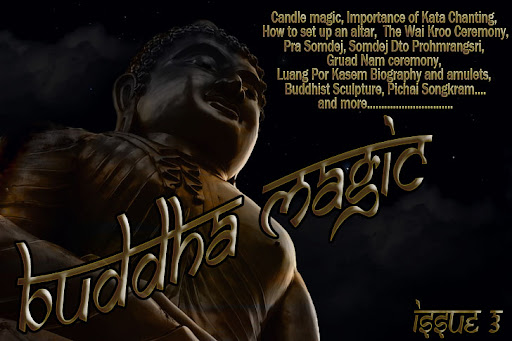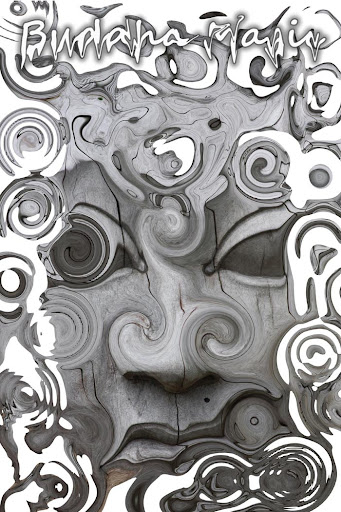
For those who visit Sak-Yant.com and are readers of my Buddha Magic publications, Issue Three of Buddha Magic is about to be released. Here is a list of most of the contents for you to ponder upon. as well as a link to a slideshow with screenshots of the content of some of the pages of the Ezine.
Buddha Magic Issue three 30thDecember 2010 New Year Edition
Contents
-
Intro
-
Candle Magic
used in Theravada Buddhism – Chapter Two; Tian Look Sagod
Magic Bead Candle Meditation and the Wicha of Wat Plab temple. -
Pra Somdej –
King of Thai Amulets – Part Three of the ongoing series about
Pra Somdej amulets, all amulets of the Six E -
Somdej Pra
Puttajarn (Dto) Prohmrangsri (Wat Rakang Kositaram). Part Three
of the Biography and Legends of Somdej Dto Prohmrangsri, maker of
the Legendary Pra Somdej Wat Rakang – King of Thai amulets. This
third part of the series begins with what is perhaps one of Somdej
Dtos signature works, and the subject of Legend – the ‘Pra Kata
Chinabanchorn’ – The Chinabanchara Mantra. This Kata is chanted by
almost all Thai people everywhere in Thailand, and is considered to
be one of the most Sacred Kata for Chanting – Kata Chinabanchorn –
The Kata is transliterated for Chanting phonetically. -
Luang Por Kasem
Khemago – Tan Khemago Bhikkhu (Luang Phu Kasem, or, Luang Por
Kasem, Khemago), is an extremely revered monk of the Lanna tradition
who the is considered one of the greatest Ajarn of modern Thai
history, and has a massive and devoted following in the North of
Thailand (and indeed all over the country). His devotees believe
that to pay reverence to him or wear his amulets, results in
receiving protection and safety wherever they go. His amazing
dedication to his practice and purity is common knowledge with Thai
people, which is easy to see since the very beginning of his path as
he gave up the title of abbot of the temple and went to practice
Vipassana Kammathana forest tradition methods residing in an old
cemetery in the forest on a mountain side, which is where heremained
practicing in humility and simplicity to the end of his mortal days -
About Kata
Chanting – The Benefits of Chanting Pra Kata – Chanting
is an essential part of the Thai Theravada Buddhist Practice. The
blessings and benefits of Chanting Kata are evident in various
aspects of life. The Buddha himself stated that there are 5 ways to
enlighten to any Dhamma or to become fully enlightened, and that one
of them was whilst Praying, or Chanting Prayers. (Authors personal
writing) -
Somdej Dto’s
Sermon on the Benefits of Chanting Prayers – Tan Jao Prakhun
Somdej Dto Prohmrangsri was once invited to the Ngan Mahad of Jao
Praya Sanpaetcharapakdee, in the times of King Rama 4, to give a
sermon – this is the transcript of that Sermon (rough Translation). -
Pra Kata
Chinabanchorn of Somdej Dto
– The Legend of the
Chinabanchara and where it came from. -
Pra Kata Bucha
Khor Laap Jed Wan – Seven Day Chant for Luck and Riches – A
set of seven Kata to be chanted during the whole week. It is a Kata
to improve your Fortune and to increase Riches, as well as acquiring
Metta Mahaniyom charm and Happiness, Respect and related Auspicious
Blessings. -
Kata For When
Luck and Business Sales are Down; Ancient Kata from the hand of
Por Hnaan Bun Ban. The Kata is called ‘Montr Kaa Khaay Bpen Dtok,
meaning ‘Kata to sell till you drop’ -
How to Empower
Nam Montr – Methods for making your own Magical Prayer Water
(Nam Montr) using Kata Chanting (and candles as an optional
addition) -
Kata for
various Deities; Brahma, Garuda, Naga, Vishnu, Pra Laks, Various
Ruesi (Por Phu Narot, Por Phu Narai, Por Phu Hnaa Suea). -
What to offer
the Deities – The necessary offerings for making Bucha to the
Deities. How to make Bucha offerings to the Ruesi Deities. -
About Animal
headed Ruesi; Legends of the Monkey, Tiger and Deer Faced Ruesi
Deities. -
Naga Head Ruesi
– Pra Rasi Gasirotha -
Kata Pra Laks Hnaa Tong – The Mantra for Pra Laks – Deity of
attraction charm and luck. -
Deity Portrait
– Pra Laks – In Thai
Culture and spiritualist belief, there is a very popular and
powerful magical charm and incantation which bears the Name of Pra
Laks, called ‘Na Hnaa Tong’ or ‘Na Pra Laks Hnaa Tong’. This means
literally “Golden Faced Pra Laks”. -
Various Kata
for Riches -
Kata for Deity
Taw Waes Suwan – The correct Mantras for Lord Taw waes Suwann,
Northern King of the Jatumaharachiga Realm, iconic Asura Deity of
the those with great riches. -
Kata Hua Jai –
Important Heart Mantras – short abbreviated easy to remember,
but extremely powerful root Kata to chant and invoke your
protective, healing or charming energy with. -
Saan Pra Poom –
Saan Jao Tee Jao Tang, Saan Prohm – Spirit Shrines; A shrine
house for the local spirits, ghosts or Deities to reside in. Almost
every Buddhist home has one of these in Thailand.There are three
main forms of spirit house; Saan Pra Poom, Saan Jao Tee and Saan
Prohm; This article explains in great detail (10 pages) about this
tradition and the ceremony which is performed to invoke the Deities. -
Pitii Gruad Nam
– Pouring Water Ceremony to
offer Fruits of your Merits to the Dead; What instruments to
use forGruad Nam? When is the best time to perform Gruad Nam
Ceremony?,Benefits of Dedicating Merit. Dtamnan Gruad Nam –
legendary Origins of the Ceremony. -
Pra Putta Roop
Bpaed Samay – Continuation of the series; ‘Eight Eras of
Buddhist Art and Sculpture’, which began in Issue one with a full
synopsis of the Eight Main Artistic Eras of Thai Buddhist Art and
Sculpture, and continues every issue presenting different Buddha
Statues from Different Eras and Cultural Styles, and the story
behind their origin. This Month the following Two Sculptures are
presented; -
Pra Luang Por
Dto – Luang Por Dto is a classic example of Sukhothai Period
Sculpture. -
Luang Por Tong
Kam – late Ayuttata Period Buddhist Sculpture
You can see slideshow pics of the contents of issue 3 on the following link;
http://picasaweb.google.com/sakyant/BuddhaMagicIssue3
I hope that you will be interested enough to buy Buddha Magic Issue 3, the project needs more support and more readers still to ensure its survival. If the Project survives and proves workable, then Buddha magic Ezine will be a major contribution to my financing of the Sak yant foundation Project, which now has various Monks and Ruesi masters willing to join in on the comittee and be master of Ceremonies and give teachings at the Ashram of the Foundation.
you can now purchase it at the blogspot site or at www.sak-yant.com/Buddha-Magic as of 30th December 2010
Buy it Here!>>>>>>> Buddha Magic Issue Three
Thanks in advance to all who support the Buddha Magic Project by purchasing.
Regards Spencer Littlewood, Author, Buddha Magic Ezine
Sponsored Ad



